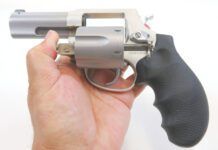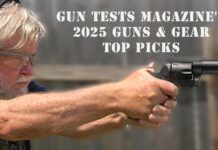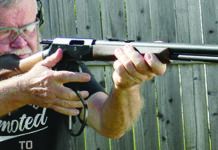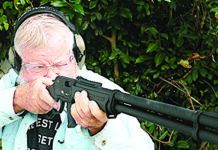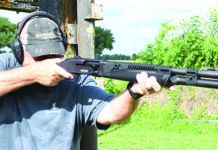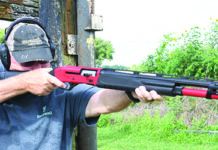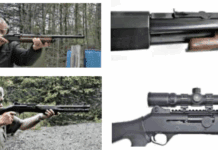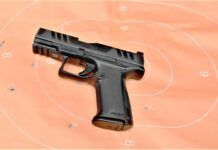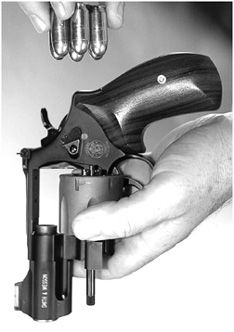
Since the introduction of high-capacity pistols, the revolver has been playing catch-up in terms of sales and popularity. With the sunset of the 10-shot limitation on magazines, it would stand to reason that the revolver would now be at an additional disadvantage. Surprisingly, however, revolvers continue to have a following, for obvious reasons:
The advantages of a revolver include simplicity and reliability. At its most basic level, loading a revolver does not require pulling back a slide. Also, a revolver will fire just about any round that can be fit into the chamber without worry about bullet type, proper crimp, overall length or adequate power to cycle the slide. Disadvantages of the revolver are led by its limited capacity, limits to concealment (dictated primarily by the width of the cylinder) and in many cases, more weight than most people wish to carry. In this test we will evaluate three powerful revolvers that use expensive alloys to reduce weight. One of the guns, the Smith & Wesson 327, is machined for eight-shot capacity of either .38 Special or .357 Magnum ammunition. The other two guns were the .45 ACP Smith & Wesson 325PD, which holds six fat rounds, and the .41 Magnum Taurus M415, which is a five-shooter. Many shooters may see the rounds these guns shoot and wonder if the guns’ power offsets their limited capacity. Also, though reduction in weight would obviously make these guns easier to wear every day, they would also make recoil more pronounced.
We were also concerned with functional problems or side effects that might result from the use of alloys such as titanium and scandium. How well would these guns clean up after use, and were they prone to damage from familiar cleaning supplies?
To test the guns, we used Houston’s Top Gun indoor shooting range (www.topgunrange.com). Our test distance for collecting data was 15 yards, and we shot the guns from a sandbag rest. Here is what we learned.
[PDFCAP(1)]
The Smith & Wesson website (www.smith-wesson.com) describes the 325PD as the “Perfect back country ‘high power’ pack gun.” If you have ever tried carrying one of this gun’s steel-framed cousins, namely the .45 ACP 625 series revolvers, then you know that big-bore revolvers are heavy. The lightest stainless steel 625 currently listed weighs in at 43 ounces or, nearly twice that of the 325PD. Sure, the 325PD will fit nicely into a knapsack, but what about on the hip or in a briefcase?
The 325PD was built on the Smith & Wesson N-frame, which is larger than all other models save for the X-frame-based Model 500 Magnum. But with its short barrel and round-butt grip, it was easy to mistake this 325PD for a gun built on the midsized L-frame instead.
The black finish of the scandium frame contrasted with the gray titanium cylinder. We checked with Smith & Wesson and learned that keeping their titanium and scandium guns clean meant extra care. This was because the scandium models are finished with a coating that provides a surface tension that adds to the strength of the material. Most cleaners will not strip this coating, but testing on an area such as the portion of the frame underneath the grip is a good idea. The left side of the frame sported the Smith & Wesson logo and a series of dots that indicated where the different pins were mounted. The right side was adorned with more logos and two sideplate screws. The words “SPFLD, MA” and “S&W USA” were laser-engraved on the right side.
The two-piece cocobolo grip left the backstrap exposed, contributing to the 325PD’s concealability. This dark coloration made the gun look smaller than it really was, but when we placed the 325PD on top of a 5-inch stainless-steel 627, the only size difference was in the barrel lengths.
The barrel shroud was also scandium, and it fully enclosed the ejector rod. Lock-up was braced with the tip of the ejector rod, and there was no detent in the crane. Shielding on the frame directly above the forcing cone prevented cutting from gases escaping as the bullet crosses the break between the cylinder and the barrel. A relieved cylinder release made loading and ejection easy, as did a cutaway contour of the grip. A key-operated hammer lock, placed discretely above the cylinder release, allows the action to be locked. These features are shared with the Smith & Wesson 327.
The wide-tang hammer and the smooth, wide trigger (no trigger stop) had been blackened to blend with the frame. The rear sight was the standard Smith & Wesson design, adjustable for windage and elevation. But a V-shaped notch was supplied instead of a rectangular shape. This matched up well with the red-colored HiViz light-gathering front sight. Despite the front sight sitting tall on a stanchion, the shooter was not aware of the front-sight blade unless the gun was aimed too high. The object of this visual package was to settle the red dot into the crook of the V.
The 325PD arrived with half-moon clips to hold the ammunition in place. A half-moon clip holds three rounds, so two clips were required to load six rounds. We found the half-moon clips difficult to work with. Due to their small size and unsymmetrical shape, they were hard to load and painfully difficult to work with when it came time to remove the spent cases. The use of a “de-mooning” tool only helped us break one of the clips. We thought it was ironic that a gun that utilized the latest technology and materials would rely on outmoded half-moon clips. We solved this problem by ordering a set of Wilson Combat full-moon clips for $4.95 from Brownells, (800) 741-0015.
The 325PD will fire without clips in place, but the shooter has to pry each spent shell out individually. Also, you run the risk of misfires by creating too much distance between the firing pin and the primer. The full-moon clips worked just as we hoped. Loading and unloading the gun was fast and sure, and removing spent shells from the clips with a de-mooner was a cinch.
Another advantage of full-moon clips: If your household situation demands it, you can keep the gun empty and separate from a loaded moon clip. Loading a full-moon clip in an emergency isn’t a problem.
But the central issue in evaluating a 23-ounce .45 ACP revolver was recoil. We wouldn’t want a gun that caused the defensive shooter pain or injury. Our [PDFCAP(2)] consisted of the 230-grain JHP round from Black Hills Ammunition, 185-grain BEB WinClean ammunition from Winchester USA, and a handload of fresh components that was developed for target work with a custom 1911 pistol. The handload consisted of Hodgdon’s Clays powder in fresh Remington (R-P head stamp) cases. The 230-grain FMJ bullets were product number 123 from Zero Bullets (800-204-1526), and once-loaded overall length was 1.25 inches.
Even though there’s some loss of pressure at the break where the bullet crosses into the revolver’s forcing cone, recoil was still an issue — so much so that we removed the wood grip and replaced it with a rubber Hogue monogrip. This vastly improved our ability to shoot the PD comfortably and accurately, as the results in the Accuracy and Chronograph table show.
Notably, however, the lighter-recoiling handload varied only as little as 0.3 inch per group, showing us that it was easier to be consistent when a strong effort to grip the gun was not as critical. Perhaps the key to choosing the best round for a super light weight revolver is to handload ammunition to a velocity that results in recoil within one’s own personal limits. Thankfully, the adjustable rear sight should allow the shooter to match bullet weight, velocity and point of impact for any type of round.
[PDFCAP(3)]
The Smith & Wesson 327 is an eight-shot revolver based on the N frame. The 327 provides magnum firepower and capacity that challenges most pistols fed from a single-column magazine. Just like the 325PD, the 327’s black frame was scandium and the gray cylinder was titanium. The mouth of each chamber has been chamfered, to hasten the loading of fresh rounds. The 327’s gray barrel shroud was also made from titanium, and it enclosed a 2-inch stainless steel barrel liner, which was visible from the muzzle.
The 327’s frame size is the same as the 325PD or any other roundbutt N-frame revolver, but the short barrel and shroud gave this gun an unusually “snubby” look. The trigger was smooth and thin, with a case-hardened look and a fixed overtravel stop. The hammer had the same finish as the trigger. The wood grips on both Smith & Wesson revolvers were by Ahrens, and the 327’s grip included finger grooves, unlike the grips on the 325PD. In terms of shooter comfort and control, we didn’t like the wood grips nearly as much as the rubber Hogue Monogrip.
The 327 had a short ramp-style orange-colored front sight. The rear sight consisted of a notch machined into the top strap. According to Smith & Wesson, ammunition loaded with a 158-grain bullet was used to zero this type of revolver. Considering that the rear sight is not adjustable for elevation, using a different bullet weight or a different ammunition speed would require changing the front sight to adjust the point of impact. Fortunately, the 327’s front sight dovetail makes it feasible to change the front sight and adjust POI elevation.
Listed with an MSRP of nearly $1,200, this gun may seem utilitarian, but it did offer sophisticated features as well. For one, the crane is reinforced with a large ball detent running parallel to the ejector rod, which assures lockup. Probably the most appealing feature was the 327’s ability to load and fire with or without the full moonclips provided.
But there are two aspects of this gun that concerned us. First, the ejector rod was woefully short, which slowed our ability to clear the chambers. Second, we fired a 125-grain JHP .38 Special +P round from Black Hills, 150-grain JHP rounds from PMC that offered exposed lead at the tips, and 150-grain Star Fire JHP rounds, also from PMC. In the case of the .38 Special +P rounds and the spent .357 Magnum Star Fire cases, both came out easily. But the standard PMC hollowpoints glued themselves into the chambers, as did other randomly chosen magnum ammunition. Mounting the ammunition on the moon clips did seem to help, but the gun really needed a full-length ejector rod. To do that, however, the barrel and shroud would have to be longer as well.
Actually, we would welcome a longer barrel on this gun. This would balance the gun visually, produce more velocity at the muzzle, push exit flash and noise further away from the shooter, and make the gun less top heavy in the holster.
At the range, we found that for all the recoil we were experiencing, our test ammunition was not performing as we would have expected. According to our Oehler chronograph (Oehler Research, Inc., 800-531-5125), velocity was limited by the short 2-inch barrel.
For this comparison, we used the same lot of Black Hills .38 Special +P ammunition as we did in a November 2004 test of inexpensive .357 Magnum revolvers. There was a sizable difference in velocity. The Black Hills Ammunition 125-grain JHP round averaged 874 fps fired from the Taurus 605B in November. The S&W 327 revolver could only manage an average velocity of 818 fps, despite having a barrel length measuring just 0.1 inches shorter than the Taurus 605B.
Our most accurate round in this test was the PMC Star Fire 150-grain JHP .357 Magnum ammunition. Our average group measured 2.0 inches, with variation in size stretching from 1.2 to 2.7 inches. We think this wider-than-expected gap between largest and smallest groups was due to the difficulties of controlling a lightweight gun filled with hot ammunition.
[PDFCAP(4)]
Taurus lists the five-shot M415SH2C as a “compact” frame, and the use of titanium makes the gun about 10 ounces lighter than the stainless-steel version. According to the Taurus website (www.taurususa.com), compact frames are in between sizes small and medium. Several compact .41 Magnum revolvers are available, but the only .41 Magnum Taurus that chambers a sixth round is built on the larger Raging Bull frame.
The Shadow Gray finish of our Taurus was subtle and appealing. We checked with Taurus regarding upkeep of this finish and were told that damage from solvents has not been reported. The rubber grip was one piece and had soft ribs that adjusted to the shape of our fingers. The grip also covered the backstrap, adding recoil protection.
The crane lockup included a spring-loaded detent, which allowed the tip of the ejector rod to turn freely. Should the ejector rod become bent, it has less of a chance of interfering with rotation. A full-lug shroud protected the ejector rod and also covered the stainless-steel barrel. The hammer tang was wide and checkered, and the trigger was wide and smooth. The hammer included a key-operated lock that pops up to block it from being pulled back. Unlike the flat mainspring found in the Smith & Wesson revolvers, the Taurus hammer drew power from a coil mainspring. We found the trigger pull on this gun to be smooth, but we noticed stacking in the trigger pull before letting off a double-action shot.
At first glance there did not seem to be much difference in size between the Taurus M415SH2C and the Smith & Wesson N-framed models 327 or 325PD. Measured side by side, however, the Taurus was indeed more compact. The Taurus was about 0.3 inch smaller in height, measuring from the bottom of the frame area just ahead of the trigger guard to the bore line. The Taurus was also shorter from the trigger guard to the forward end of the frame. But the overall width of the five-shot Taurus was only 0.1 inch thinner than the six- and eight-shot Smith & Wesson revolvers. The determining factor was the amount of material between the wall of the chambers and the outer diameter of the cylinder. The Taurus offered more material to add strength.
At the range we found that the 21-ounce Taurus shooting .41 Magnum rounds was a real handful. The power and recoil of the .41 Magnum rounds tested our limits severely. Our test ammunition consisted of the 175-grain Silvertip hollowpoints by Winchester, and two 210-grain rounds from PMC and Federal. We found PMC’s TCSP cartridges, whose bullets were truncated cone soft points that had a hollow tip exposing the lead, and the Federal Classic Hi-Shok ammunition recoiled so much that we had to wear a padded glove. The bullet weight and velocity of these two rounds made accurate shooting difficult and unpleasant. Recorded velocities of more than 1000 fps produced muzzle energy in the 500 foot-pounds range from the 2.6-inch barrel. Our best groups measured more than 4 inches on average at 15 yards from a sandbag rest. In contrast, with 175-grain Winchester Silvertip HP rounds we saw perfectly acceptable 2.8-inch average groups with 390 foot-pounds of muzzle energy.
We ended up with this selection of test ammunition because they were the only three rounds immediately available. This is something to keep in mind when choosing a handgun. Will the ammunition you like best be available at a moment’s notice? Of course, handloading is an option, but fresh .41 Magnum cases may also be in limited supply.
Gun Tests Recommends
• Smith & Wesson 325PD .45 ACP, $907. Conditional Buy. The 325PD felt balanced and compact. Overall, this .45 ACP revolver seemed to the best conceived weapon of our trio. In our view, hot defense loads will make it recoil too much for most people, but in our opinion big bullets don’t need to be traveling at warp speed to be effective.
• Smith & Wesson 327 .38 Special/.357 Magnum, $1,179. Conditional Buy. The 2-inch barrel and short ejector rod dampened our enthusiasm for the 327. We liked the eight-round capacity and the versatility of .38/.357, and we wouldn’t flinch at the price if the barrel was 3 or 4 inches long.
• Taurus M415SH2C .41 Magnum, $602. Conditional Buy. This gun was slim, simple, and relatively inexpensive. Its greatest strength, and weakness, was the power of its chambering. Unless there are lower-recoil “personal defense” .41 Magnum rounds available, we would leave this round to hunting aficionados or choose Taurus’s .44 Special Total Titanium model for friendlier big-bore carry.




